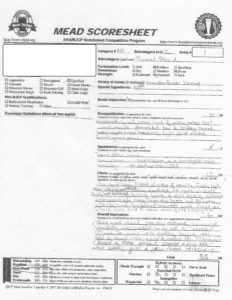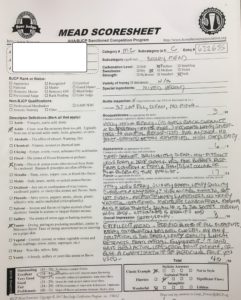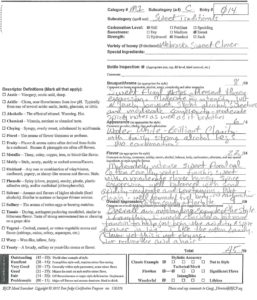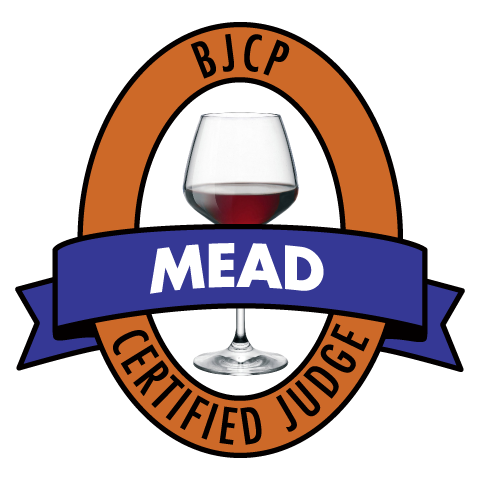By Andrew Luberto
As anyone who has ever done so can tell you, entering a home mead into a competition takes some serious time and a fair amount of money. So it can be pretty disappointing when you get a scoresheet back that doesn’t provide a good evaluation of your product. The components of any scoresheet, whether its beer, mead, or cider generally all follow the same basic structure of descriptive evaluation of the product, non-biased judging, and helpful feedback. However, where a scoresheet may fall short can land in a few broad categories that could include: misevaluating the mead because of an unfamiliarity with ingredients or process; not understanding the product and what should be perceived; sparsely filling out or an incomplete sheet or; not having a good grasp on evaluating mead in general. For more on properly evaluating mead check out this previous newsletter article. Luckily mead evaluation has vastly improved from the days when some just expected to taste a dominant raw honey sweet character. That being said, there’s always room for improvement! So with that in mind, here are some thoughts from both experienced judges and entrants on what makes up a quality scoresheet.
What are entrants looking for?
To get a better perspective on what entrants are looking for I asked Tom Repas, the 2018 recipient of The American Meadmaker Association’s National Meadmaker of the Year, to weigh in on what he expects from judges when entering a competition and explain what he looks for in a quality scoresheet.
Besides relevant commentary and useful feedback, Tom Repas talked about some key elements such as objectivity, humility and kindness.
On objectivity Repas writes, “Judges must try to minimize their own personal biases as much as possible. What I mean is, don’t tell me that my dry mead entry should have been made as a sweet mead- instead of being left dry- simply because you like sweet mead better…. Instead, if the dry mead which I entered is out of balance, tell me that, and then describe what I might do to improve it (which could actually include back sweetening as one option for me to consider). “
“Another example is if I entered a fruit-only mead, don’t tell me that I should have added spices…Comments such as that are unhelpful. Please just judge the mead in front of you and not the mead you wish I had made.”
Repas goes on to discuss the error of making assumptions about ingredients or process when evaluating a mead, he writes; “…Please keep in mind that you don’t know the whole back story. When writing your comments, try to think how what you write will seem to the entrant who does know the whole story. You will seem very foolish if you are too sure of yourself in your comments…”
Lastly, he believes that kindness is a critical factor in making a good scoresheet. He writes, “If an entry has problems- be honest – but don’t go out of your way to be harsh.”
“Remember, the entrant may just be a complete beginner who is just starting out and is still learning. We want mead makers to keep learning, to keep entering competitions, and to improve what they make over time…Being excessively mean and negative in your comments serves no purpose.”
Scoresheet Evaluation
To get a more tangible idea of what makes up a good mead scoresheet, I reached out to some very experienced mead judges and BJCP graders and asked them to evaluate some scoresheets and offer advice for improvement. The judges for this exercise were, Michael Bury, Grandmaster II judge, Associate Exam Director, and Assistant Competition Director; Ryan Thomas Grandmaster III judge and Exam Director; and Steve Piatz Grandmaster X judge, recipient of the BJCP Pat Baker Award, and author of “The Complete Guide to Making Mead: The Ingredients, Equipment, Processes, and Recipes for Crafting Honey Wine”. Using the submissions of a few very kind volunteers, the group evaluated four different mead scoresheets.

Mike Bury:
Focuses heavily on the special additions in the mead instead of hitting all of the attributes in the mead, ie, next to no comments about the honey and fermentation characteristics in the mead. Descriptions leave a bit to be desired with the use of “some” quite often. Comes off as lacking confidence in what they’re tasting. Although the feedback is solid, I wished it aided the brewer more especially in process. For example, the phrase of “coffee dissipates too quickly” helps a little but doesn’t offer suggestions on how to improve it either.
Steve Piatz:
Overall, the description never mentions honey though all the space is filled. The text nominally indicates why the mead doesn’t earn a 50 and explains what is wrong with it. Purists that approach judging as being a checkbox where you need to cover every point (the fine print under each heading) will be disappointed here. I think the sheet is better than many competition sheets I’ve received.
Ryan Thomas:
- Doesn’t mention honey in the aroma
- Fairly high mark for “scorched coffee”
- “in the nose” “on palate” phrases are unnecessary
- How is it not balanced?
- No mention of honey in the flavor (or anywhere really)
- Marks fruity and floral but doesn’t write about them
- Score assigned seems higher than the mead described deserves.

Mike Bury:
A mostly complete scoresheet that addresses the attributes in the mead although it doesn’t appear that the individual knew what flavor contributions come from Meadowfoam honey. Feedback seemed to come more from a beer judge than a mead judge, ie, proper levels of sulfite can reduce oxidative reactions in mead instead of splashing. The mazer may also have degassed passed the 1/3 sugar break, etc. I would’ve preferred to see other guidance than increasing the acidity amount to balance the sweetness as this can produce a sweet-tart flavor that’s undesirable.
Steve Piatz:
I found parts of this sheet really hard to read.
This sheet shows the judge ticking the various items in the fine print as they covered them however the resultant text in each section doesn’t provide a vivid description of the mead like that in the previous sheet.
I cringe when I see a flavor description start with “Nice …”
Perhaps it was fairly well balance but then we get lingering bitterness which seems like a contradiction, later could use a touch more acid. So not really well balanced.
Based on the comments I would think the score was high for this mead.
Ryan Thomas
- Excellent descriptive language throughout
- Actionable feedback is provided (acidity to balance sweetness)
- Touches lightly on the honey but doesn’t compare to expectations for the varietal.
- “Few tweaks necessary” would imply the Excellent rubric rating
- Otherwise very solid scoresheet.

Mike Bury:
A high quality scoresheet especially in the context of normal judging parameters. The perception of the mead corresponds appropriately to the overall score. The judge produced a complete scoresheet by using checkboxes as well as every attribute in each sub-section was commented on, ie, thoroughness. I can easily envision what the mead was like although it’s now making me thirsty. Feedback was appropriate for the single issue detected and provided a couple of points guiding the mazer to a better, future product. Personally, I like to see a bit more variety when in comes to descriptions especially in the intensity category.
Steve Piatz:
Overall this one seems good and even readable.
No need to say “no honey variety identified” under aroma and flavor; amounts to a waste of space or an attempt to make the sheet look full of comments when it isn’t.
The flavor section seems to conclude the mead finishes toward the sweet. Under OI there is no comment related to the sweet balance while the mead was entered as dry. High acids and/or tannins sometimes can require high residual sweetness for balance while resulting in a mead that is perceived as fairly dry. A hydrometer might show a high FG while your palate says dry. Can be hard for novice entrants to determine where to put such a mead – I always say go with your perception not the lab readings. Judges need to be prepared to handle these cases.
Ryan Thomas:
- Very thorough coverage of the prompts. Good job trying to separate and identify the fruits used.
- Judge attempts to describe an off flavor that he cannot readily identify, and attempts to provide some corrective steps.
- Very strong scoresheet with no gaps.

Mike Bury:
A solid scoresheet that touches on all attributes of the mead. Descriptions at times become too generic and don’t allow the reader to completely picture the beverage being evaluated. For example, it was stated “..moderate clover honey spice expression, well balanced with good acidity.” Not all clover honey is created equal, what spice was detected, and what level is “good” acidity? Feedback was appropriate considering the score of the mead. What I appreciate is that despite the score given that suggestions for further improvement were still given. If it’s not a 50, every judge should be providing constructive feedback on improvement to the meadmaker.
Steve Piatz:
Again I found a few places hard to read. In particular the last two lines of the overall impression.
An improvement would to indicate which spice(s) are noted in this mead with the assumption they are fermentation byproducts as this is a traditional mead.
Balance description notes “good” acidity but under OI it seems to imply that more tannin would help bring the acidity in line and near the end I think it says reduce the acidity.
In the check box area the left two boxes are checked on the middle section with a faint line connecting them. When I do something like that I try to fully shade between the two when I am indicating between the two.
Ryan Thomas:
- “Pleasant honey expression… just lovely” – ok, you like it, but this is not a description.
- References to sweetness in aroma, but sweet generally is not an aroma, and alcohol isn’t typically sweet.
- Better flavor descriptors are used for the honey.
- “Good acidity” is pretty meaningless, but then follows up with an actual intensity.
- Complete coverage of the prompts with the exception of alcohol in flavor.
- I like to see the multiple suggestions for improvement. Adding tanning might be viable with the current batch where reducing acid would likely not.
- Floral checkbox should be marked.
Guided training and relevant experience is the foundation to being a good judge, however, there are other factors that may be less apparent. For example, continual education. Judging is a perishable skill and knowledge (especially in mead making) changes rapidly. Keeping your palate sharp and your knowledge base current is a critical factor to being a good judge. In addition, as Tom Repas noted, having a frame of mind of helpfulness and kindness goes a long way in how your evaluation is received. Remember that an entrant spent much time and a bit of money getting that bottle to your table (and may even be sitting at a nearby table within hearing distance). Lastly, a bit of humility and keeping an open mind when comparing your perception to other judges while entertaining the possibility that your perception may be off or missing something is an excellent way to keep your feedback accurate. Being more concerned with being right instead of being accurate only leads to looking foolish (not to mention hurt feelings).


